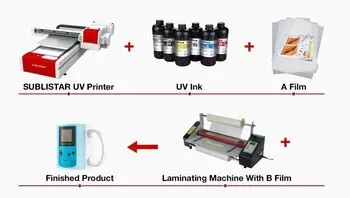In the fast-paced realm of printing technologies, **UV DTF (Direct to Film) technology** has emerged as a revolutionary force. This method artfully merges the benefits of traditional printing with cutting-edge techniques, offering vivid, high-quality prints that appeal to both consumers and businesses. As industries increasingly seek personalization and sustainability, UV DTF technology rises to meet these demands with its eco-friendly inks and rapid production capabilities. Not only does it enhance the durability of prints, but it also ensures they remain vibrant and intact across various materials. This article will explore the science that powers UV DTF technology, highlighting its core advantages and diverse applications in the printing sector.
UV DTF printing, also known as direct-to-film printing, represents a significant advancement in the sphere of industrial printing techniques. By utilizing ultraviolet light for immediate curing, this sustainable printing technology allows for swift production and exceptional print quality on a variety of surfaces. Additionally, it offers custom printing solutions, making it an ideal choice for businesses looking to innovate their product offerings. As the demand for personalized merchandise grows, understanding the intricacies of UV DTF technology becomes essential for those seeking to leverage the benefits of modern printing methodologies.
Unpacking the Mechanics of UV DTF Technology
UV DTF technology fundamentally combines the best elements of traditional printing and modern engineering. The core process involves printing digitally onto a special film, which is then cured under ultraviolet (UV) light. This innovative curing technique triggers a chemical reaction that solidifies the inks almost instantaneously. As a result, the prints possess an impressive vibrancy and durability that surpasses many conventional printing methods. This quick curing process not only saves time but also enhances the prints’ resistance to fading and abrasion, making them ideal for various applications.
Furthermore, the application of UV DTF technology goes beyond mere printing with enhanced durability; it allows for remarkable flexibility in terms of substrate use. Whether it’s t-shirts, tote bags, or even hard surfaces like wood and plastic, this technology accommodates a wide range of materials, promoting creativity and innovation in design. Businesses can leverage this versatility to meet diverse consumer demands efficiently, which is critical in today’s fast-paced market.
Frequently Asked Questions
What is UV DTF Technology and how does it work?
UV DTF (Direct to Film) Technology is an innovative printing method that uses ultraviolet light to cure ink on transfer films. This process involves printing a digital image onto a special film, which is then cured with UV light. This technology enhances the adhesion of the ink to diverse materials, leading to vibrant and durable prints.
How does UV DTF Technology compare to traditional printing methods?
UV DTF technology offers superior durability and adhesion compared to traditional printing methods. Unlike conventional inks, UV-curable inks have lower VOCs and cure instantly under UV light, leading to faster production times and eco-friendliness. This makes UV DTF an ideal option for customized printing solutions across various materials.
What are the applications of UV DTF Technology in industrial printing?
UV DTF technology is widely used in industrial printing applications such as custom labels, signage, and promotional items. Its ability to maintain print quality on various surfaces makes it perfect for sectors that require high durability and detailed graphics, such as machinery marking and customized product branding.
Is UV DTF Technology a sustainable printing technology?
Yes, UV DTF Technology is considered a sustainable printing technology due to its use of UV-curable inks, which emit lower levels of volatile organic compounds (VOCs) compared to traditional inks. This environmentally friendly approach reduces harmful emissions during the printing process, aligning with modern sustainability initiatives.
Can UV DTF Technology be used for custom apparel printing?
Absolutely! UV DTF Technology is increasingly popular for custom apparel printing because it produces high-quality, vibrant designs that retain their integrity even after industrial washing. This versatility allows brands to cater to the growing demand for personalized clothing options.
What are the recent advancements in UV DTF Technology?
Recent advancements in UV DTF Technology include improved print head precision, faster curing mechanisms, and the integration of AI in the printing process. These innovations enhance print quality, speed up production times, and allow for sophisticated color matching, making UV DTF a cutting-edge solution in the printing industry.
| Key Feature | Description |
|---|---|
| High Adhesion and Durability | Exceptional adherence to various materials such as fabric, plastic, and metal, ensuring long-lasting prints. |
| Versatility | Can print on a wide range of surfaces, suitable for textiles, promotional items, and more. |
| Environmental Impact | Utilizes UV-curable inks with lower VOCs, reducing harmful emissions and improving eco-friendliness. |
| Quick Production Times | Fast drying process allows businesses to meet urgent demands efficiently without compromising quality. |
| Customization | Supports high-resolution and intricate designs, enabling personalized products for customers. |
Summary
UV DTF technology is a revolutionary printing innovation that is transforming the industry with its ability to deliver high-quality, durable prints across a variety of materials. Utilizing UV light to cure ink, this method ensures exceptional adhesion, vibrant colors, and resistance to wear, making it ideal for everything from apparel to promotional items. Businesses leveraging UV DTF technology can benefit from quick production times and eco-friendly practices, setting a new standard in customization and versatility. As this technology continues to evolve, it positions itself as a key player in meeting the increasing demand for personalized and sustainable printing solutions.

